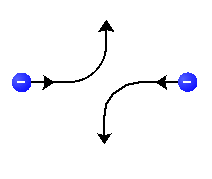Ab Initio Many-Body Theory for Real Matter
 The
electronic and optical properties of matter (for example, a metal,
semiconductor, or more complex man-made nanostructures) are governed by
the quantum-mechanical motion of the electrons inside the material.
Since electrons have a negative charge, they repel each other strongly,
and their motion becomes correlated
as they swerve to avoid one another. The purpose of many-body theory is
to describe and understand this correlation using fundamental quantum
mechanics, and hence obtain an understanding of the role of correlation
in the properties of the material.
The
electronic and optical properties of matter (for example, a metal,
semiconductor, or more complex man-made nanostructures) are governed by
the quantum-mechanical motion of the electrons inside the material.
Since electrons have a negative charge, they repel each other strongly,
and their motion becomes correlated
as they swerve to avoid one another. The purpose of many-body theory is
to describe and understand this correlation using fundamental quantum
mechanics, and hence obtain an understanding of the role of correlation
in the properties of the material.
Traditionally, many-body theories have been formulated for simple
models that are believed to encapsulate the relevant physics of
a particular phenomenon. Now, however, it is possible to combine
advances in computer hardware and algorithms with the ideas of
many-body theory to create a many-body theory that does not rely
on the correct guessing of the physics at the start of the calculation:
the basic equations of quantum mechanics are solved from first
principles on powerful computers, using controllable approximations
rather than ad hoc models. The physical picture emerges
from analysis of the calculation.
Early applications included quasiparticle energies of semiconductors [1], the electronic
properties of a small metallic cluster [2] and a metal surface [3]. Other studies include understanding the changing nature
of the electronic self-energy operator (a kind of dynamic, non-local potential
that represents the effect of the electronic correlation on the motion of each
individual electron) in systems where electronic correlation is stronger [4], and the calculation of accurate ground-state total energies for
systems of interacting electrons [5].
More recently, we have started to explore many-body perturbation theory using our iDEA code [6].
1. "Accurate exchange-correlation potential for silicon and its discontinuity on addition of an electron", R.W. Godby, M. Schlüter and L.J. Sham, Physical Review Letters 56 2415 (1986). Abstract
2. "Ab initio calculations of the quasiparticle and absorption spectra of clusters: the sodium tetrameter", G. Onida, L. Reining, R.W. Godby, R. Del Sole and W. Andreoni, Physical Review Letters 75 818 (1995). Abstract
3. "Dynamic image potential at an Al(111) surface", I.D. White, R.W. Godby, M.M.
Rieger and R.J. Needs, Physical Review Letters 80 4265-4268 (1998). Abstract
4. "Systematic vertex corrections through iterative solution of Hedin's equations beyond the GW approximation", A. Schindlmayr and R.W. Godby, Physical Review Letters 80 1702 (1998). Abstract
5. "Many-body GW calculations of ground-state properties: quasi-2D electron systems and van der Waals forces", P. García-González and R.W. Godby, Physical Review Letters 88 056406 (2002) [4 pages]. Abstract
6. "GW self-screening error and its correction using a local density functional", J. Wetherell, M.J.P. Hodgson and R.W. Godby, Physical Review B (Rapid Communications) 97 121102(R) (2018). Abstract
Full list of publications
Return to Rex Godby's home page
 The
electronic and optical properties of matter (for example, a metal,
semiconductor, or more complex man-made nanostructures) are governed by
the quantum-mechanical motion of the electrons inside the material.
Since electrons have a negative charge, they repel each other strongly,
and their motion becomes correlated
as they swerve to avoid one another. The purpose of many-body theory is
to describe and understand this correlation using fundamental quantum
mechanics, and hence obtain an understanding of the role of correlation
in the properties of the material.
The
electronic and optical properties of matter (for example, a metal,
semiconductor, or more complex man-made nanostructures) are governed by
the quantum-mechanical motion of the electrons inside the material.
Since electrons have a negative charge, they repel each other strongly,
and their motion becomes correlated
as they swerve to avoid one another. The purpose of many-body theory is
to describe and understand this correlation using fundamental quantum
mechanics, and hence obtain an understanding of the role of correlation
in the properties of the material.